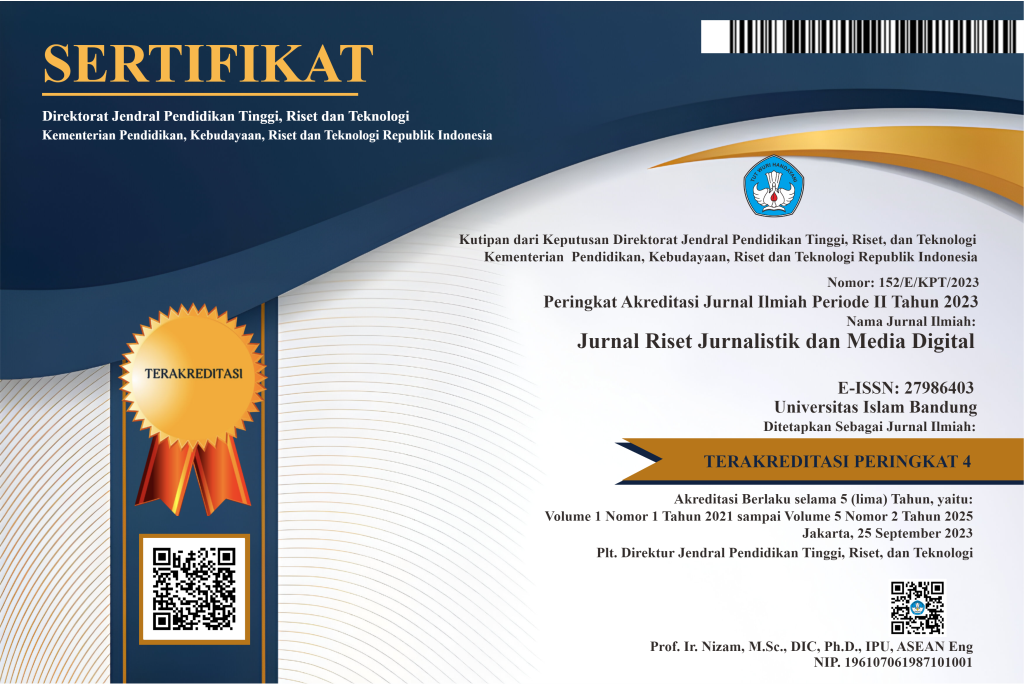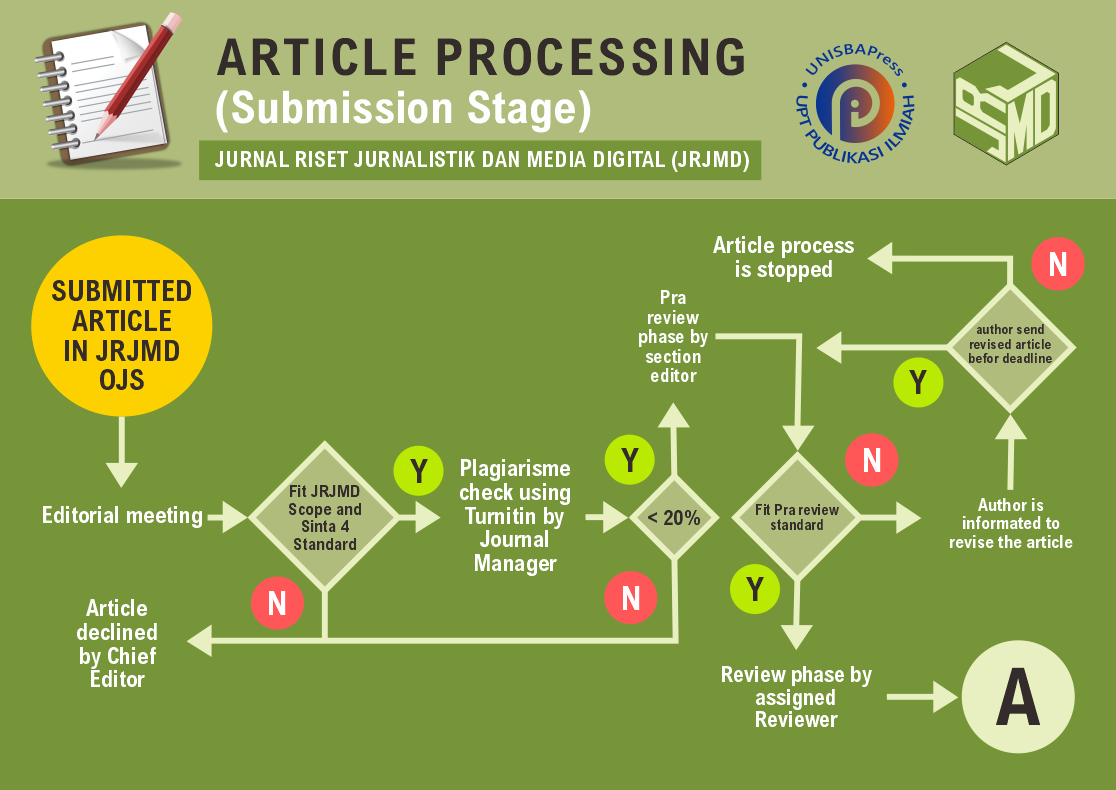Anatomi dan Literasi Post-Truth
DOI:
https://doi.org/10.29313/jrjmd.v2i2.1359Keywords:
Post-Truth, Media Sosial, DigitalAbstract
Abstract. Post-truth has become a jargon in conversation and discussion. The concept of the theory is complex and becomes a challenge in itself to ground it in the general public. The dangers of post-truth in everyday life are real. Post-truth is a broader concept as well as more fluid than hoaxes, so post-truth is more difficult to detect, identify and handle than hoaxes. However, the current available digital literacy tends to be more in the form of black-and-white literacy: distinguishing between facts and not. Meanwhile, post-truth tends to be in the gray area between facts and non-facts, which works by exploiting one's prejudices based on ideology, group logic, moral claims, and other aspects beyond facts or non-facts. The literacy process needs to be gradually adjusted to the needs of the community. However, it is important to refine our literacy model in an approach that is able to mitigate the post-truth modus operandi. For this purpose, this paper will be divided into two main parts, namely anatomical maps and post-truth literacy. The discussion will be sub four four. First, classify the truth; second, the post-truth dimension; post-truth manipulation mode; and the post-truth literacy model. This paper concludes that post-truth can be handled, or at least minimized, if the individual has sensitivity to language, discipline in scientific logic, sensitivity in recognizing the ecological influence of media, sensitive to biased ideology, and has accuracy in carrying out his duties.
Abstrak. Istilah post-truth telah menjadi jargon di banyak pembicaraan dan pembahasan. Konsep teoritisnya kompleks dan menjadi tantangan tersendiri untuk membumikannya di masyarakat umum. Bahaya post-truth di kehidupan sehari-hari adalah nyata. Post-truth merupakan konsep yang lebih luas sekaligus lebih cair dibanding hoaks, sehingga post-truth lebih sulit untuk dideteksi, diidentifikasi dan ditangani dibanding hoaks. Namun, arus literasi digital yang tersedia cenderung lebih terkonsentrasi pada bentuk literasi yang hitam-putih: membedakan mana fakta dan bukan. Sementara itu, post-truth cenderung berada di area abu-abu antara fakta dan bukan fakta, yang cara kerjanya menggunakan eksploitasi prejudis seseorang berdasarkan ideologi, logika kelompok, klaim moral, dan aspek-aspek lain di luar fakta ataupun non-fakta. Proses literasi memang perlu bertahap menyesuaikan dengan kebutuhan masyarakat. Akan tetapi, adalah penting untuk menyempurnakan model literasi kita pada pendekatan yang mampu memitigasi modus operandi post-truth. Untuk tujuan tersebut, tulisan ini akan dibagi menjadi dua bagian utama, yakni peta anatomi dan literasi post-truth. Pembahasannya akan akan dibagi menjadi empat sub. Pertama, klasifikasi kebenaran; kedua, dimensi post-truth; modus manipulasi pos-truth; dan model literasi post-truth. Tulisan ini menyimpulkan bahwa, post-truth dapat ditangani, atau setidaknya diminimalisir, bila individu telah memiliki sensitivitas terhadap penyalahgunaan bahasa, kedisiplinan dalam logika ilmiah, sensitivitas dalam mengenali pengaruh ekologi media, peka terhadap bias ideologis yang dimilikinya, dan punya ketelitian dalam melakukan penafsiran.
References
Adam, Asvi Warman. 2006. Sejarah, Nasionalisme Dan Kekuasaan. Jakarta: Equinox Publishing.
Ananta, Aris. 2006. Mudharat Dan Manfaat Statistik Ekonomi Sosial. Singapura: Equinox Publishing.
Ball, James. 2017. Post-Truth: How Bullshit Conquered the World. London: Biteback Publishing.
Baron, Ilan Zvi. 2018. How to Save Politics in the Post-Truth Era. Manchester: Manchester University Press.
Barzilai, S., and C. A. Chinn. 2020. “A Review of Educational Responses to the ‘Post-Truth’ Condition: Four Lenses on ‘Post-Truth’ Problems.” Educational Psychologist 55(3):107–19.
Boseley, Sarah. n.d. Mbeki AIDS Denial ‘Caused 300,000 Deaths. The Guardian.
Budiman, Arif. 1986. Sistem Perekonomian Pancasila Dan Ideologi Ilmu Sosial Di Indonesia. Jakarta: Gramedia.
Bunz, M. 2014. “The Silent Revolution: How Digitalization Transforms Knowledge, Work, Journalism and Politics without Making Too Much Noise.” In The Silent Revolution: How Digitalization Transforms Knowledge, Work, Journalism and Politics without Making Too Much Noise.
Cahya, G. H. 2020. “’It’s Meant to Help: Harvard Professor Responds After Government Dismisses Study on Undetected Coronavirus.” The Jakarta Post.
Farid, H. 2006. Masalah Kelas Dalam Ilmu Sosial Indonesia. Singapura: Equinox Publishing.
Floridi, L. 2014. The Fourth Revolution. New York: Oxford University Press.
Kalpokas, I. n.d. “A Political Theory of Post-Truth.” In A Political Theory of Post-Truth.
Krahenbuhl, K. S. 2021. “The Clearing House : A Journal of Educational Strategies , Teaching for the Pursuit of Truth in a Post-Truth World Teaching for the Pursuit of Truth in a Post-Truth World.” The Clearing House 94(1):31–37.
Krasmann, S. 2020. “The Logic of the Surface: On the Epistemology of Algorithms in Times of Big Data.” Information Communication and Society 23(14):2096–2109.
McComiskey, Bruce. 2017. Post-Truth Rhetorics and Compositions. Utah: Utah State University Press.
Rakhmani, I., and M. S. Saraswati. 2021. “Authoritarian Populism in Indonesia: The Role of the Political Campaign Industry in Engineering Consent and Coercion.” Journal of Current Southeast Asian Affairs.
Ward, K. 2018. “Social Networks, the 2016 US Presidential Election, and Kantian Ethics: Applying the Categorical Imperative to Cambridge Analytica’s Behavioral Microtargeting.” Journal of Media Ethics: Exploring Questions of Media Morality 33(3):133–148.
Woolley, S. C., and P. N. Howard. 2019. Computational Propaganda; Political Parties, Politicians, and Politik Manipulation on Social Media. Oxford: Oxford University Press.
Zuboff, S. 2019. “Surveillance Capitalism and the Challenge of Collective Action.” New Labor Forum 28(1):10–29.














